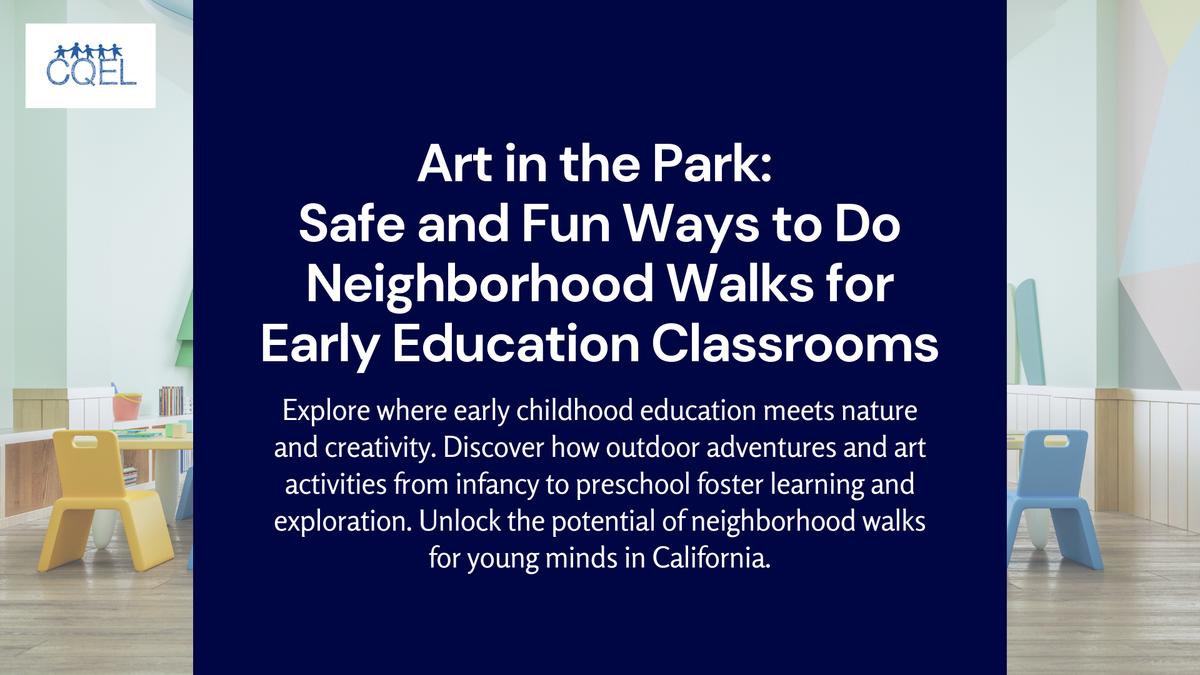Art in the Park: Safe and Fun Ways to Do Neighborhood Walks for Early Education Classrooms
Explore where early childhood education meets nature and creativity. Discover how outdoor adventures and art activities from infancy to preschool foster learning and exploration. Unlock the potential of neighborhood walks for young minds in California.

In the world of early childhood education, outdoor adventures are essential for nurturing young minds from infancy through preschool. "Art in the Park" represents an exciting opportunity to merge the wonders of nature with creative expression, tailor-made for children from babies to five years old. Aspiring childcare providers in California hold the key to unlocking the potential of neighborhood walks enriched with art activities, laying the foundation for a lifelong love of learning and exploration.
Outdoor exploration offers a myriad of benefits for children in their formative years, starting from the earliest stages of infancy. Neighborhood walks provide infants and toddlers with sensory-rich experiences, stimulating their curiosity and cognitive development. For preschoolers, outdoor activities promote physical activity and gross motor skills while fostering social-emotional growth and environmental awareness. By immersing children in nature and the community from a young age, childcare providers set the stage for holistic development and meaningful learning experiences.
Planning safe and engaging neighborhood walks for children ages babies through five requires thoughtful preparation and attention to detail. Caregivers must select walking routes and parks that are accessible and age-appropriate, taking into account the unique needs and abilities of young children. Conducting thorough safety checks and risk assessments prior to excursions ensures that potential hazards are identified and mitigated. Establishing clear guidelines and procedures for outdoor activities helps maintain structure and security, ensuring a positive and enriching experience for children and caregivers alike.
Integrating art activities into neighborhood walks adds an exciting dimension to outdoor exploration, fostering creativity and self-expression in young children. Even babies can engage in sensory-based art experiences, such as finger painting with natural materials like leaves or flowers. Toddlers may enjoy creating nature collages or exploring different textures and colors found in the environment. Preschoolers can participate in more complex art projects, such as nature-inspired sculptures or collaborative murals, promoting collaboration and imagination.
Facilitating learning and reflection during neighborhood walks is essential for helping young children make meaningful connections with their surroundings. Caregivers can encourage infants and toddlers to observe and explore the natural world through their senses, laying the foundation for scientific inquiry and language development. Preschoolers can engage in discussions and storytelling related to their outdoor experiences, deepening their understanding of concepts like seasons, weather, and community. Reflective practices, such as documenting observations or creating nature journals, provide opportunities for children to express themselves and communicate their ideas.
Supporting differentiated learning and inclusive practices ensures that all children, regardless of age or ability, can fully participate in outdoor activities. Caregivers must adapt activities to meet the developmental needs and interests of each child, providing sensory-friendly experiences for children with special needs. Cultivating a culture of respect and acceptance promotes an inclusive learning environment where every child feels valued and supported, laying the groundwork for future success in school and beyond.
Navigating the legal and safety considerations of neighborhood walks requires careful attention to detail and adherence to regulations. Caregivers must ensure compliance with health and safety guidelines, such as maintaining appropriate adult-to-child ratios and implementing emergency procedures. Seeking guidance from reputable organizations like Californians for Quality Early Learning (CQEL) can provide valuable support and resources to help childcare providers navigate legal and safety considerations effectively. By prioritizing safety and compliance, childcare providers can create a secure and nurturing environment for outdoor learning experiences, setting the stage for a lifetime of exploration and discovery.
Walks can offer a delightful and enriching experience for children ages babies through five, blending nature with creative expression in a safe and engaging environment. With the support of caregivers and organizations like CQEL, childcare providers in California can unlock the potential of outdoor exploration, fostering a love of learning that lasts a lifetime. By embracing the wonders of nature and the community, early education program owners and directors can empower young children to become curious, compassionate, and confident individuals, ready to explore the world around them with joy and enthusiasm.
